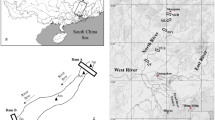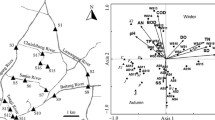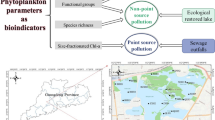Abstract
To test the serial discontinuity concept (SDC) predictions in a regulated river ecosystem, environmental parameters and phytoplankton community structure were determined in a subtropical river (China) which was regulated by 11 cascade dams. Our results showed that total phosphorus (TP) and silicate during the wet period in several dams supported the SDC predictions. Variations of phytoplankton species composition in several cascade dams, such as Datengxia (DTX) and Changzhou (CZ), also supported the SDC predictions. Moreover, the stations near the dams showed the maximum or minimum values of total species numbers in each cascade segment. Predictive model indicated that the types of phytoplankton decreased in the middle reaches, conforming to SDC predictions. In the whole system of cascading dams, an increase in silicate concentration and phytoplankton communities in the downstream was also consistent with SDC predictions. Therefore, these findings aligned with the SDC predictions in the aspects of both single dam and whole cascade dam system to some extent. In future research, our aim is to further investigate the effects of cascade damming on additional phytoplankton-related indices in this aquatic ecosystem. We hope to gather more comprehensive data to fully validate the SDC predictions.








Similar content being viewed by others
Data availability
No datasets were generated or analysed during the current study.
References
Almeida, R. M., Hamilton, S. K., Rosi, E. J., Arantes, J. D., Barros, N., Boemer, G., Gripp, A., Huszar, V. L. M., Junger, P. C., Lima, M., Pacheco, F., Carvalho, D., Reisinger, A. J., Silva, L. H. S., & Roland, F. (2019). Limnological effects of a large Amazonian run-of-river dam on the main river and drowned tributary valleys. Scientific Reports, 9, 6846. https://doi.org/10.1038/s41598-019-53060-1
Arcifa, M. S., Coelho, P. N., Da Silva, L., & Righi-Cavallaro, K. O. (2023). Impacts of small dams on the phytoplankton and invertebrates in an Amazonian river. River Research and Applications, 39, 661–674. https://doi.org/10.1002/rra.4103
Baldwin, D. S., Wilson, J., Gigney, H., & Boulding, A. (2009). Influence of extreme drawdown on water quality downstream of a large water storage reservoir. River Research and Applications. https://doi.org/10.1002/rra.1255
Bilous, O., Lilitskaya, G., & Kryvenda, A. (2015). Seasonal variability of Southern Bug River upstream phytoplankton. International Journal on Algae, 2015, 37–49. https://doi.org/10.1615/InterJAlgae.v17.i1.40
Bovo-Scomparin, V.M., Train, S., & Rodrigues, L.C. (2013). Influence of reservoirs on phytoplankton dispersion and functional traits: A case study in the Upper Paraná River, Brazil. Hydrobiologia, 702, 115–127. https://doi.org/10.1007/s10750-012-1313-8
Cellamare, M., Morin, S., Coste, M., & Haury, J. (2012). Ecological assessment of French Atlantic lakes based on phytoplankton, phytobenthos and macrophytes. Environmental Monitoring and Assessment, 184, 4685–4708. https://doi.org/10.1007/s10661-011-2295-0
Costanza, R., Arge, R. D., Groot, S. F., & Belt, M. (1997). The value of the world’s ecosystem services and natural capital. Nature, 387, 253–260. https://doi.org/10.1016/S0921-8009(98)00020-2
Da Silva, I.G.F.M. (2020). Loss of phytoplankton functional and taxonomic diversity induced by river regulation in a large tropical river. Hydrobiologia 847. https://doi.org/10.1007/s10750-020-04355-2
De Castro, L. S., Arago, D. S. L. A., Colares, L., Palheta, L., Mayko, D. S. M., Fernandes, L. M., & Dunck, B. (2021). Dam promotes downriver functional homogenization of phytoplankton in a transitional river-reservoir system in Amazon. Limnology, 22, 245–257. https://doi.org/10.1007/s10201-021-00650-6
Dong, A., Yu, X., Yin, Y., & Zhao, K. (2022). Seasonal variation characteristics and the factors affecting plankton community structure in the Yitong River, China. International Journal of Environmental Research and Public Health, 19, 17030. https://doi.org/10.3390/ijerph192417030
Duong, T. T., Nguyen, H. Y., Le, T. P. Q., Nguyen, T. K., & Mcgowan, S. (2019). Transitions in diatom assemblages and pigments through dry and wet season conditions in the Red River, Hanoi (Vietnam). Plant Ecology and Evolution, 152, 163–177. https://doi.org/10.5091/plecevo.2019.1627
Ebs, A., Bab, A., Teck, A., Aep, B., Fpw, C., Bdd, A., Rcd, C., Mcm, D., Kdc, E., & Jlo, A. (2019). Spatial variability of phytoplankton in a shallow tidal freshwater system reveals complex controls on abundance and community structure - ScienceDirect. Science of The Total Environment, 700. https://doi.org/10.1016/j.scitotenv.2019.134392
Ellis, L. E., & Jones, N. E. (2013). Longitudinal trends in regulated rivers: A review and synthesis within the context of the serial discontinuity concept. Environmental Reviews, 21, 136–148. https://doi.org/10.1002/rra.2861
Fang, Y.J., Wang, X.W., Ren, J., Liu, H. & Wang, Y. (2023). Driving forces and influences of flood diversion on discharge fraction and peak water levels at an H-shaped compound river node in the Pearl River Delta, South China. Water 15. https://doi.org/10.3390/w15111970
Graco-Roza, C., Soininen, J., Corrêa, G., Pacheco, F. S., Miranda, M., Domingos, P., & Marinho, M. M. (2021). Functional rather than taxonomic diversity reveals changes in the phytoplankton community of a large dammed river. Ecological Indicators, 121, 107048. https://doi.org/10.1016/j.ecolind.2020.107048
Guzy, J. C., Eskew, E. A., Halstead, B. J., & Price, S. J. (2018). Influence of damming on anuran species richness in riparian areas: A test of the serial discontinuity concept. Ecology & Evolution. https://doi.org/10.1002/ece3.3750
Hou, Z. J., Jiang, Y., Liu, Q., Tian, Y. L., He, K. J., & Fu, L. (2018). Impacts of environmental variables on a phytoplankton community: A case study of the tributaries of a subtropical river, southern China. Water, 10, 152. https://doi.org/10.3390/w10020152
Husnain, T. W., & Masunaga, T. (2009). Dissolved silica dynamics and phytoplankton population in Citarum watershed, Indonesia. Journal of Food Agriculture & Environment, 7, 655–661. https://doi.org/10.3168/jds.2009-92-7-3543
Istvánovics, V., Honti, M., Vrs, L., & Kozma, Z. (2010). Phytoplankton dynamics in relation to connectivity, flow dynamics and resource availability—The case of a large, lowland river, the Hungarian Tisza. Hydrobiologia, 637, 121–141. https://doi.org/10.1007/s10750-009-9991-6
Jackson, F. L., Hannah, D. M., Fryer, R. J., Millar, C. P., & Malcolm, I. A. (2017). Development of spatial regression models for predicting summer river temperatures from landscape characteristics: Implications for land and fisheries management. Hydrological Processes, 31(26), 1225–1238. https://doi.org/10.1002/hyp.11087
Jung, S. W., Kwon, O. Y., Yun, S. M., Joo, H. M., Kang, J. H., & Lee, J. H. (2014). Impacts of dam discharge on river environments and phytoplankton communities in a regulated river system, the lower Han River of South Korea. Journal of Ecology & Environment, 37, 1–11. https://doi.org/10.5141/ecoenv.2014.001
Kaushal, S. S., Likens, G. E., Jaworski, N. A., Pace, M. L., Sides, A. M., Seekell, D., Belt, K. T., Secor, D. H., & Wingate, R. L. (2010). Rising stream and river temperatures in the United States. Frontiers in Ecology and the Environment, 8, 461–466. https://doi.org/10.1890/090037
Kim, D., Ji, R., Feng, Z., Jang, J., Lee, D., Lee, W. C., & Kang, C. (2023). Estuarine dam water discharge enhances summertime primary productivity near the southwestern Korean coast. Marine Pollution Bulletin, 191, 114971. https://doi.org/10.1016/j.marpolbul.2023.114971
Köhler, J. (1994). Origin and succession of phytoplankton in a river-lake system (Spree, Germany). Hydrobiologia, 289, 73–83. https://doi.org/10.1007/BF00007410
Li, J. P., Dong, S. K., Liu, S. L., Yang, Z. F., Peng, M. C., & Zhao, C. (2013). Effects of cascading hydropower dams on the composition, biomass and biological integrity of phytoplankton assemblages in the middle Lancang-Mekong River. Ecological Engineering, 60, 316–324. https://doi.org/10.1016/j.ecoleng.2013.07.029
Li, G., Liu, J., Diao, Z., Jiang, X., Li, J., Ke, Z., Shen, P., Ren, L., Huang, L., & Tan, Y. (2017). Subsurface low dissolved oxygen occurred at fresh- and saline-water intersection of the pearl river estuary during the summer period. Marine Pollution Bulletin, 126, 585–591. https://doi.org/10.1016/j.marpolbul.2017.09.061
Li, H., Ge, D., Yang, W., Zeng, Y., Liu, Q., Gao, Y., Mai, Y., & Wang, C. (2022). Taxa composition and ecological traits of filamentous diatoms in a regulated fragmented river, China. Fundamental and Applied Limnology, 195, 305–323. https://doi.org/10.1127/fal/2022/1404
Li, J., Xiao, X., Xian, X., Li, S., Yu, X., & Zhang, X. (2023). Green algae outcompete cyanobacteria in a shallow lake, Longhu Lake. Water Supply, 23, 2649–2661. https://doi.org/10.2166/ws.2023.154
Litchman, E., & Klausmeier, C. A. (2008). Trait-based community ecology of phytoplankton. Annual Review of Ecology Evolution & Systematics, 39, 615–639. https://doi.org/10.1146/annurev.ecolsys.39.110707.173549
Litchman, E. (2007). Resource competition and the ecological success of phytoplankton. Evolution of Primary Producers in the Sea, 351–375. https://doi.org/10.1016/B978-012370518-1/50017-5
Liu, L., Yang, Z., Delwiche, K. B., Long, L., & Lorke, A. (2020). Spatial and temporal variability of methane emissions from cascading reservoirs in the Upper Mekong River. Water Research, 186, 116319. https://doi.org/10.1016/j.watres.2020.116319
Maavara, T., Parsons, C. T., Ridenour, C., Stojanovic, S., Dürr, H. H., Powley, H. R., & Van Cappellen, P. (2015). Global phosphorus retention by river damming. Proceedings of the National Academy of Sciences, 112, 15603–15608. https://doi.org/10.1073/pnas.1511797112
Mohanty, T. R., Tiwari, N. K., Kumari, S., Ray, A., Manna, R. K., Bayen, S., Roy, S., Das Gupta, S., Ramteke, M. H., & Swain, H. S. (2022). Variation of Aulacoseira granulata as an eco-pollution indicator in subtropical large river Ganga in India: A multivariate analytical approach. Environmental Science and Pollution Research, 29, 37498–37512. https://doi.org/10.1007/s11356-021-18096-9
Mwedzi, T. (2016). Longitudinal macroinvertebrate assemblages in contrasting discontinuities: The effects of damming in tropical streams. African Journal of Ecology, 54. https://doi.org/10.1111/aje.12281
Negro, A. I., Hoyos, C. D., & Vega, J. C. (2000). Phytoplankton structure and dynamics in Lake Sanabria and Valpara??so reservoir (NW Spain). Hydrobiologia, 424, 25–37. https://doi.org/10.1023/A:1003940625437
Nguyen, G.T. & Dan, H.T. (2020). Interrelation of phytoplankton and water quality at Bung Binh Thien Reservoir, An Giang Province, Vietnam. Scientific Journal of Tra Vinh University. https://doi.org/10.26554/IJEMS.2020.4.4.110-115
Nogueira, Ferrareze, M., Moreira, M. L., & Gouvêa, R. M. (2017). Phytoplankton assemblages in a reservoir cascade of a large tropical-subtropical river (SE, Brazil). https://doi.org/10.1590/S1519-69842010000400009
Pathak, D., Hutchins, M., Brown, L., Loewenthal, M., Scarlett, P., Armstrong, L., Nicholls, D., Bowes, M., & Edwards, F. (2021). Hourly prediction of phytoplankton biomass and its environmental controls in lowland rivers. Water Resources Research, 57. https://doi.org/10.1029/2020WR028773
Penczykowski, R. M., Fearon, M. L., Hite, J. L., Shocket, M. S., Hall, S. R., & Duffy, M. A. (2023). Pathways linking nutrient enrichment, habitat structure, and parasitism to host–resource interactions. Oecologia. https://doi.org/10.1007/s00442-023-05469-9
Poff, L. R., Olden, J. D., Merritt, D. M., & Pepin, D. M. (2007). Homogenization of regional river dynamics by dams and global biodiversity implications. Proceedings of the National Academy of Sciences of the United States of America, 104. https://doi.org/10.1073/pnas.0609812104
Rejeb, S., Duveau, C., & Rebafka, T. (2022). Self-organizing maps for exploration of partially observed data and imputation of missing values. https://doi.org/10.48550/arXiv.2202.07963.
Resende, N. D. S., Santos, J. B. O. D., Josué, I. I. P., Barros, N. O., & Cardoso, S. J. (2022). Comparing spatio-temporal dynamics of functional and taxonomic diversity of phytoplankton community in tropical cascading reservoirs. Frontiers in Environmental Science, 10. https://doi.org/10.3389/fenvs.2022.903180
Rychteck, P., & Znachor, P. (2011). Spatial heterogeneity and seasonal succession of phytoplankton along the longitudinal gradient in a eutrophic reservoir. Hydrobiologia, 663, 175–186. https://doi.org/10.1007/s10750-010-0571-6
Saulino, H. H., Leite-Rossi, L. A., & Trivinho-Strixino, S. (2017). The effect of small reservoirs on chironomid diversity and trait composition in savanna streams: Evidence for serial discontinuity concept. Hydrobiologia, 793, 109–119. https://doi.org/10.1007/s10750-016-3013-2
Shen, H., Ye, L., Cai, Q., & Tan, L. (2022). Longitudinal variations in physiochemical conditions and their consequent effect on phytoplankton functional diversity within a subtropical system of cascade reservoirs. Frontiers in Ecology and Evolution, 10. https://doi.org/10.3389/fevo.2022.914623.
Silva, I. G. D., Colares, L. F., Palheta, L., Gadelha, E., & Dunck, B. (2023). Taxonomic and functional homogenisation of zooplankton after river damming in Central Brazil. Freshwater Biology, 68, 1776–1788. https://doi.org/10.1111/fwb.14165
Song, Y., Shen, L., Zhang, L., Li, J., & Chen, M. (2021). Study of a hydrodynamic threshold system for controlling dinoflagellate blooms in reservoirs. Environmental Pollution, 278, 116822. https://doi.org/10.1016/j.envpol.2021.116822
Stanford, J. A., & Ward, J. V. (2001). Revisiting the serial discontinuity concept. River Research & Applications, 17, 303–310. https://doi.org/10.1002/rrr.659
Wang, C., Li, X., Lai, Z., Tan, X., Pang, S., & Yang, W. (2009). Seasonal variations of Aulacoseira granulata population abundance in the Pearl River Estuary. Estuarine Coastal & Shelf Science, 85, 585–592. https://doi.org/10.1016/j.ecss.2009.09.031
Wang, C., Lai, Z., Li, Y., Li, X., & Li, J. (2012). Population ecology of Aulacoseira granulata in Xijiang River. Acta Ecologica Sinica, 32, 4793–4802.
Wang, C., Li, X., Wang, X., Wu, N., Yang, W., Lai, Z., & Lek, S. (2016a). Spatio-temporal patterns and predictions of phytoplankton assemblages in a subtropical river delta system. Fundamental and Applied Limnology / Archiv Für Hydrobiologie, 187, 335–349. https://doi.org/10.1127/fal/2016/0866
Wang, C., Lek, S., Lai, Z., & Tudesque, L. (2017). Morphology of Aulacoseira filaments as indicator of the aquatic environment in a large subtropical river: The Pearl River, China. Ecological Indicators, 81, 325–332. https://doi.org/10.1016/j.ecolind.2017.06.020
Wang, C., B-Béres, V., Stenger-Kovács, C., Li, X., & Abonyi, A. (2018). Enhanced ecological indication based on combined planktic and benthic functional approaches in large river phytoplankton ecology. Hydrobiologia, 818, 163–175. https://doi.org/10.1007/s10750-018-3604-1
Wang, C., Wu, N., Li, W., Liu, Q., & Fohrer, N. (2020). Curved filaments of Aulacoseira complex as ecological indicators in the Pearl River, China. Ecological Indicators, 118, 106722. https://doi.org/10.1016/j.ecolind.2020.106722
Wang, C., Jia, H., Wei, J., Yang, W., & Wu, N. (2021). Phytoplankton functional groups as ecological indicators in a subtropical estuarine river delta system. Ecological Indicators, 126, 107651. https://doi.org/10.1016/j.ecolind.2021.107651
Ward, J.V., & Stanford, J.A. (1983). The serial discontinuity concept of lotic ecosystems. In T. D. Fontaine, & S. M. Bartell (Eds.), Dynamics of lotic ecosystems (pp. 29–42). Ann Arbor, MI: Ann Arbor Science.
Wehr, J. D., & Descy, J. P. (1998). Use of phytoplankton in large river management. Blackwell Publishing Ltd. https://doi.org/10.1046/j.1529-8817.1998.340741.x
Wei, J., Li, W., Yang, W., Zeng, Y., Liu, Q., Gao, Y., Li, H., & Wang, C. (2023). Phytoplankton species richness as an ecological indicator in a subtropical, human-regulated, fragmented river. River Research and Applications, 39, 718–733. https://doi.org/10.1002/rra.4094
Whiterod, N. S., Meredith, S. N., Humphries, P., Sherman, B. S., Koehn, J. D., Watts, R. J., Ingram, B. A., & Ryan, T. (2018). Flow alteration and thermal pollution depress modelled growth rates of an iconic riverine fish, the Murray cod Maccullochella peelii. Ecology of Freshwater Fish. https://doi.org/10.1111/eff.12384
Wu, Z., Zhang, Y., Zhou, Y., Liu, M., Shi, K., & Yu, Z. (2015). Seasonal-spatial distribution and long-term variation of transparency in Xin’anjiang Reservoir: Implications for reservoir management. International Journal of Environmental Research and Public Health, 9492, 9507. https://doi.org/10.3390/ijerph120809492
Xiao, Z., Sun, J., Lin, B., & Yuan, B. (2023). Multi-timescale changes of water temperature due to the Three Gorges Reservoir and climate change in the Yangtze River China. Ecological Indicators, 148, 110129. https://doi.org/10.1016/j.ecolind.2023.110129
Xu, B., Li, Y., Han, F., Zheng, Y., Ding, W., Zhang, C., Wallington, K., & Zhang, Z. (2020). The transborder flux of phosphorus in the Lancang-Mekong River Basin: Magnitude, patterns and impacts from the cascade hydropower dams in China. Journal of Hydrology, 590, 125201. https://doi.org/10.1016/j.jhydrol.2020.125201
Xu, Y., Guo, X., Dan, Y., Yang, Z., Ma, J., Liu, D., & Xu, Y. (2021). Impact of cascade reservoirs on continuity of river water temperature: A temperature trend hypothesis in river. Hydrological Processes 35. https://doi.org/10.1002/hyp.13994
Yuan, L., Fang, L.C., Wang, Y.Z., Mi, W.J., Li, J., Zhang, G.X., Yang, P.H., Chen, Z.B., & Bi, Y.H. (2022). Anthropogenic activities accelerated the evolution of river trophic status. Ecological Indicators 136. https://doi.org/10.1016/j.ecolind.2022.108584
Zhao, Y., Zou, X., Liu, Q., Yao, Y., Li, Y., Wu, X., Wang, C., Yu, W., & Wang, T. (2017). Assessing natural and anthropogenic influences on water discharge and sediment load in the Yangtze River, China. Science of the Total Environment s, 607–608, 920–932. https://doi.org/10.1016/j.scitotenv.2017.07.002
Zhao, B., Song, P., Yang, W., Mai, Y., Li, H., Liu, Q., Zeng, Y., Gao, Y., Du, W., & Wang, C. (2022). Bacterioplankton community indicators for seasonal variation in a fragmented subtropical river. Environmental Monitoring and Assessment, 194, 458. https://doi.org/10.1007/s10661-022-10101-z
Acknowledgements
We are very grateful to all staff members of our team for their assistance during field work.
Funding
This work was supported by Guangdong Basic and Applied Basic Research Foundation (NO. 2021A1515012079 and NO. 2019A1515011589).
Author information
Authors and Affiliations
Contributions
Changxin Xie and Caiqin Hu wrote the main manuscript text and prepared figures1-8. Wanling Yang, Qianfu Liu and Jingxin Wei collected the data. All authors reviewed the manuscript.
Corresponding author
Ethics declarations
Ethics approval
All authors have read, understood, and have complied as applicable with the statement on “Ethical responsibilities of Authors” as found in the Instructions for Authors.
Competing interests
The authors declare no competing interests.
Additional information
Publisher's Note
Springer Nature remains neutral with regard to jurisdictional claims in published maps and institutional affiliations.
Changxin Xie and Caiqin Hu contribute equally to this work and should be considered as co-first authors.
Rights and permissions
Springer Nature or its licensor (e.g. a society or other partner) holds exclusive rights to this article under a publishing agreement with the author(s) or other rightsholder(s); author self-archiving of the accepted manuscript version of this article is solely governed by the terms of such publishing agreement and applicable law.
About this article
Cite this article
Xie, C., Hu, C., Yang, W. et al. Phytoplankton species composition as bioindicator in the largest fragmented channel of the Pearl River, China. Environ Monit Assess 196, 389 (2024). https://doi.org/10.1007/s10661-024-12551-z
Received:
Accepted:
Published:
DOI: https://doi.org/10.1007/s10661-024-12551-z




